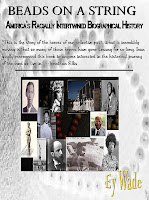Kindle, Smashwords , Sony or Kobo, Scribed
Nook and iPad here &; here.
BEADS ON A STRING-AMERICA'S RACIALLY INTERTWINED BIOGRAPHICAL HISTORY
Read interviews with the author
Read interviews with the author
 America's Only Multi-Interracial History Book. History was written in more than Black and White. Beads on a String-America’s Racially Intertwined Biographical History never stops celebrating our heritages and lauds loudly the accomplishments of all races that helped make America the great country it has become.
America's Only Multi-Interracial History Book. History was written in more than Black and White. Beads on a String-America’s Racially Intertwined Biographical History never stops celebrating our heritages and lauds loudly the accomplishments of all races that helped make America the great country it has become.Kindle, Smashwords , Sony or Kobo, Scribed
Nook and iPad.
Videos for inside the book.
Press Kits
Reviews for Beads on a String America's Racially Intertwined Biographical History

This review is from: Beads On a String-America's Racially Intertwined Biographical History (Kindle Edition)
I just finished Beads on A String and in all sincerity I have to say it is a work of subtle genius. Several years back I read one of the most unusual history books ever written, "The Peoples' History of the United States." Anyone who has read that revelation of history as events that really happened, as opposed to events as reported by those who were left holding the most power, will see a similar sort of understanding in this amazing work by Ey Wade. An alternative title for her work could well be, "A History of the People of the United States. I can give this work no higher compliment.
I was consistently fascinated by unexpected connections, accomplishments and contributions being added to the ongoing tapestry of our country by so many people from so many ethnic and cultural backgrounds, that I simply couldn't put the book down. If I could ask for anything more, it would literally be just that...more.
This is the story of the heroes of our collective past. What is incredibly moving is that so many of these heroes have gone unsung for so long.
I can gladly recommend this book to anyone interested in the historical journey of the land we live in. Beyond that, I can just as easily recommend it to anyone who just likes a great read.
5.0 out of 5 stars A Must-Read In So Many Ways, June 2, 2011
By

This review is from: Beads On a String-America's Racially Intertwined Biographical History (Kindle Edition)
I was consistently fascinated by unexpected connections, accomplishments and contributions being added to the ongoing tapestry of our country by so many people from so many ethnic and cultural backgrounds, that I simply couldn't put the book down. If I could ask for anything more, it would literally be just that...more.
This is the story of the heroes of our collective past. What is incredibly moving is that so many of these heroes have gone unsung for so long.
I can gladly recommend this book to anyone interested in the historical journey of the land we live in. Beyond that, I can just as easily recommend it to anyone who just likes a great read.
Kathy Brown
If you enjoy reading good genuine history, which is all about people, this is the most innovative and intriguingly honest perception yet, of America's roots and growth. Ey,
An amazing work - very labor intensive - and worthy of a PhD (in my humble opinion, but what do I know). Your index is just as intense as the text, for God's sake!
Thank you for giving me the opportunity to read it...just wished there were more pictures :~) @ponderdeeply:@jumpouttheboat Finished your book, "Beads On a String!" Perfect for home-schooling; very complete, heartwarming and winning material :~)
vayz has made a comment on Beads on a String-America's Racially Intertwined Biographical History (Explosion in the Sky): What can I say? You're a genius for coming up with this significant book....on the net. Hope to see the whole of it.
Keep up the good work and here's wishing you *raises glass* for more relevant e-books to come. We shall overcome... Author Vid-Lift Every Voice
Debra Harris-Johnson said...I am spellbound by your never ending talent. Your book is a breakthrough in literary history. Congratulations!!! It is well worth the money.
INTERVIEWS
Feb 4. 2012 The African American History Examiner
African-American History Examiner (AAHE): What is your book about?Ey Wade (E. W.): Beads on a String is about applause.
History was written in more than Black & White and Beads on a String-America’s Racially Intertwined Biographical History lauds loudly the accomplishments of all races that helped make America the great country it has become. America’s glorious multi-racial history is finally acknowledged.
Tired of picking up an American history book and seeing the accolades given to one ethnicity at a time? Ever wondered what the Chinese, Japanese or any other race contributed to America within a certain time frame?
Beads on a String-America’s Racially Intertwined Biographical History is the book for you to read.
With hyperlinks and videos it celebrates hundreds of people such as Hiawatha who fought for freedom of his people, Lonnie Johnson who invented the ‘Super Soaker’, Dalip Singh Saund was a member of the United States House of Representatives, Rev. Rick Warren blessed the 2008 Presidential Inauguration, Arpad G.C. Gerster was one of the first surgeons in America, Yamato Ichihashi was one of the first academics of Asian ancestry in the United States; Antonio Meucci invented the telephone, Michael Jackson entertained; Minoru Yamasaki second-generation Japanese-American architect designed the World Trade Center, and Amadeo Peter Giannini founded the of Bank of Italy which later became Bank of America.
Beads on a String-America’s Racially Intertwined Biographical History never stops celebrating our heritages from the naming of the country by Martin Waldseemuller to the elimination of overt racial discrimination, through education, entertainment and to the glorious day of racial, political and social unification with Barack Obama’s Presidential election.
AAHE: How did you pick the topic for Beads on a String-America’s Racially Intertwined Biographical History?
E. W.: At one time I was a home-schooling parent and in the process of teaching Black history month we go into the conversation of teaching Black history only once a month. I decided to write a book and teach the about the contributions of all races.
AAHE: How is Beads on a String-America’s Racially Intertwined Biographical History different from other books that cover the same or similar information?
E. W.: Beads on a String is different because it is the only American history book to include and celebrate all ethnicity which have contributed to the greatness of this country.
E. W.: I love the idea of being able to write down my thoughts and emotions, have a reader read my words and find themselves within the pages.
NAMING AMERICA
In our quest to learn about America’s colorful history and to ascertain the inclusion of the contributions from every race that has made America the great nation it is, our biggest wonder was how this great country received its name. Why the great America wasn’t called ‘Columbus’? Should this nation not have been named after the person said to have discovered the new worlds? In actual fact, it has been. In 1507 the map maker Martin Waldseemuller named North and South America, after Amerigo Vespucci.
The phrase “united States of America” was first used officially in the Declaration of Independence, adopted on July 4, 1776. On November 15, 1777, the Second Continental Congress adopted the Articles of Confederation, the first of which stated “The Stile of this Confederacy shall be ‘The United States of America.’” The name was originally proposed by Thomas Paine. Why wasn’t America named after Christopher Columbus? For a while the Americas were also known as Columbia, after Columbus, prompting the name District of Columbia for the land set aside as the U.S. capital. Columbia remained a popular name for the United States until the early 20th century, when it fell into relative disuse; it is still used poetically, and appears in various names and titles. Columbus Day is a holiday in the United States, and other countries in the Americas, commemorating Columbus’ October 1492 landing.
Mundus Novus (“New World”) was a Latin translation of a lost Italian letter sent from Lisbon to Lorenzo di Pierfrancesco de’ Medici. It describes a voyage to South America in 1501-1502. Mundus Novus was published in late 1502 or early 1503 and soon reprinted and distributed in numerous European countries. Lettera di Amerigo Vespucci delle isole nuovamente trovate in quattro suoi viaggi (“Letter of Amerigo Vespucci concerning the isles newly discovered on his four voyages”), known as Lettera al Soderini or just Lettera, was a letter in Italian addressed to Piero Soderini. Printed in 1504 or 1505, it claimed to be an account of four voyages to the Americas made by Vespucci between 1497 and 1504.
It was the publication and widespread circulation of the letters that led Martin Waldseemüller to name the new continent America on his world map of 1507 in Lorraine. Along with placing the name on the map Waldseemüller also published Vespucci’s accounts of his travels in a book. A Latin translation was published by Waldseemüller in Cosmographiae Introductio, a book on cosmography and geography, as Quattuor Americi Vespucci navigationes (“Four Voyages of Amerigo Vespucci”). Vespucci used a Latinized form of his name, Americus Vespucius, in his Latin writings, which Waldseemüller used as a base for the new name, taking the feminine form America. This public revelation caused many people to believe Vespucci was trying to steal the credit of the discovery from Christopher Columbus. And just who was this Amerigo Vespucci?
Amerigo Vespucci born March 9, 1451 was born in Florence, Italy and was an Italian merchant, explorer and cartographer. He played a senior role in two voyages which explored the east coast of South America between 1499 and 1502. On the second of these voyages he discovered that South America extended much further south than previously known by Europeans. This convinced him that this land was part of a new continent, a bold contention at a time when other European explorers crossing the Atlantic Ocean thought they were reaching Asia .
Vespucci’s real historical importance may well be more in his letters, whether he wrote them all or not, than in his discoveries. From these letters, the European public learned about the newly discovered continent of the Americas for the first time; its existence became known throughout Europe within a few years of the letters’ publication. If Vespucci’s claims are accurate he reached the mainland of the Americas shortly before Cabot, and at least 14 months before Columbus.
In 1508 Spain gave Vespucci the responsibility for training pilots for ocean voyages. He died in Seville in 1512 from Malaria.
Copyright© Ey Wade
Purchase Beads on a String-America’s Racially Intertwined Biographical History from Amazon
Ey Wade’s other book(s):
Do you have questions or comments for Ey Wade? Send them directly to her.


























0 comments:
Post a Comment